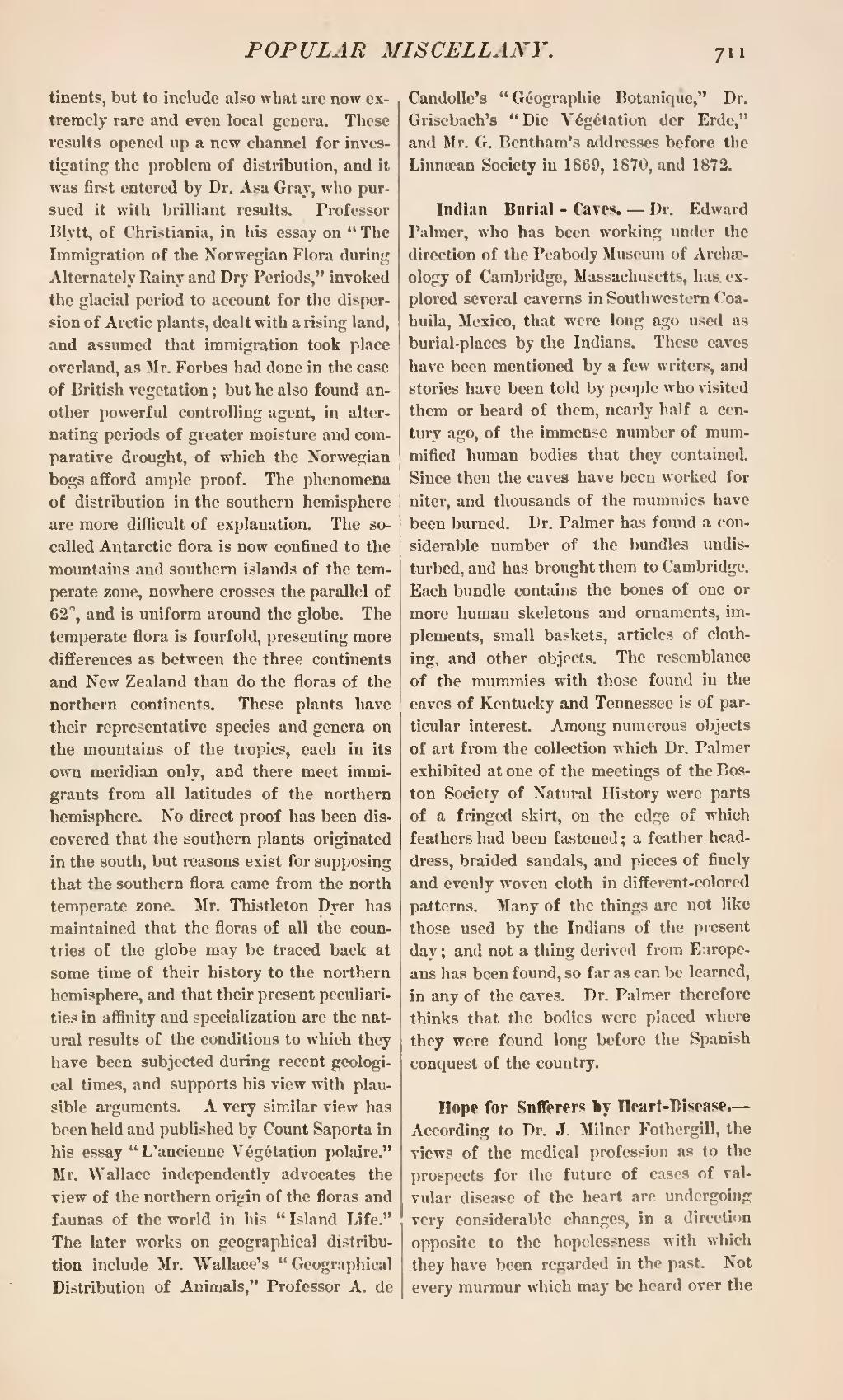tinents, but to include also what are now extremely rare and even local genera. These results opened up a new channel for investigating the problem of distribution, and it was first entered by Dr. Asa Gray, who pursued it with brilliant results. Professor Blytt, of Christiania, in his essay on "The Immigration of the Norwegian Flora during Alternately Rainy and Dry Periods," invoked the glacial period to account for the dispersion of Arctic plants, dealt with a rising land, and assumed that immigration took place overland, as Mr. Forbes had done in the case of British vegetation; but he also found another powerful controlling agent, in alternating periods of greater moisture and comparative drought, of which the Norwegian bogs afford ample proof. The phenomena of distribution in the southern hemisphere are more difficult of explanation. The so called Antarctic flora is now confined to the mountains and southern islands of the temperate zone, nowhere crosses the parallel of 62°, and is uniform around the globe. The temperate flora is fourfold, presenting more differences as between the three continents and New Zealand than do the floras of the northern continents. These plants have their representative species and genera on the mountains of the tropics, each in its own meridian only, and there meet immigrants from all latitudes of the northern hemisphere. No direct proof has been discovered that the southern plants originated in the south, but reasons exist for supposing that the southern flora came from the north temperate zone. Mr. Thistleton Dyer has maintained that the floras of all the countries of the globe may be traced back at some time of their history to the northern hemisphere, and that their present peculiarities in affinity and specialization are the natural results of the conditions to which they have been subjected during recent geological times, and supports his view with plausible arguments. A very similar view has been held and published by Count Saporta in his essay "L'ancienne Végétation polaire." Mr. Wallace independently advocates the view of the northern origin of the floras and faunas of the world in his "Island Life." The later works on geographical distribution include Mr. Wallace's "Geographical Distribution of Animals," Professor A. de Candolle's "Géographie Botanique," Dr. Grisebach's "Die Végétation der Erde," and Mr. G. Bentham's addresses before the Linnæan Society in 1869, 1870, and 1872.
Indian Burial-Caves.—Dr. Edward Palmer, who has been working under the direction of the Peabody Museum of Archaeology of Cambridge, Massachusetts, has explored several caverns in Southwestern Coahuila, Mexico, that were long ago used as burial-places by the Indians. These caves have been mentioned by a few writers, and stories have been told by people who visited them or heard of them, nearly half a century ago, of the immense number of mummified human bodies that they contained. Since then the caves have been worked for niter, and thousands of the mummies have been burned. Dr. Palmer has found a considerable number of the bundles undisturbed, and has brought them to Cambridge. Each bundle contains the bones of one or more human skeletons and ornaments, implements, small baskets, articles of clothing, and other objects. The resemblance of the mummies with those found in the caves of Kentucky and Tennessee is of particular interest. Among numerous objects of art from the collection which Dr. Palmer exhibited at one of the meetings of the Boston Society of Natural History were parts of a fringed skirt, on the edge of which feathers had been fastened; a feather headdress, braided sandals, and pieces of finely and evenly woven cloth in different-colored patterns. Many of the things are not like those used by the Indians of the present day; and not a thing derived from Europeans has been found, so far as can be learned, in any of the caves. Dr. Palmer therefore thinks that the bodies were placed where they were found long before the Spanish conquest of the country.
Hope for Sufferers by Heart-Disease.—According to Dr. J. Milner Fothergill, the views of the medical profession as to the prospects for the future of cases of valvular disease of the heart are undergoing very considerable changes, in a direction opposite to the hopelessness with which they have been regarded in the past. Not every murmur which may be heard over the
